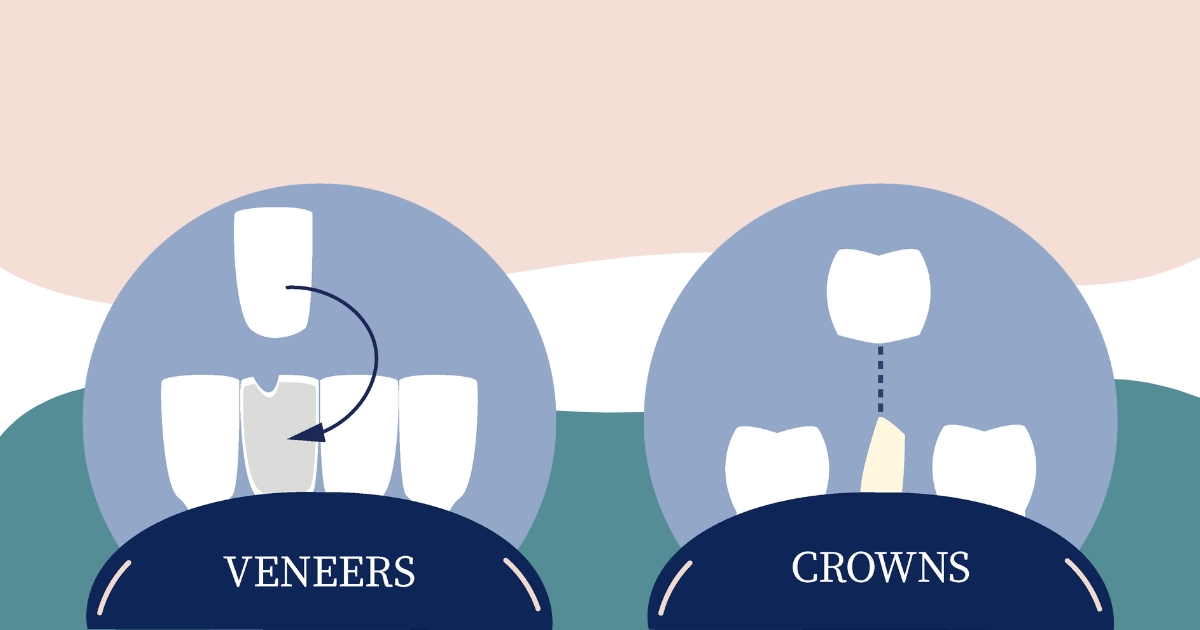How Do They Differ and Which Is the Perfect Choice for Your Smile?
You’ve heard about veneers from tabloids and celebrity gossip; they’re to thank for those pearly whites you see on everyone from Tom Cruise to Miley Cyrus. But what exactly are veneers, and how do they differ from the regal-sounding dental crown?

What are Dental Veneers and Dental Crowns?
First and foremost, dental veneers and dental crowns are intended for two separate purposes. Veneers help improve the look of one’s teeth. They are adhered to the front of the teeth for a natural look and beautiful smile. They are not intended to treat tooth structure or restore damaged teeth; they are purely cosmetic procedures. Patients can choose between porcelain veneers and resin-based composite veneers depending on their budget, the amount of time they want to spend on the process, and the look and feel they prefer.
Crowns, meanwhile, are entirely for dental restoration. Also known as a “dental cap,” crowns are great options for teeth that are cracked or chipped, damaged by decay, or embrittled by a root canal. If a patient is experiencing pain, sensitivity, looseness, or discoloration, they may be a candidate for a crown.

How do Dental Veneers Work?
A patient choosing dental veneers for cosmetic improvements can expect the entire process to take one or two visits. First, the dentist will remove a small amount of enamel from each tooth surface in order to prepare for the veneer application. The dentist will then take impressions of each tooth and have the veneers custom-made.
In a subsequent visit, the dentist will get each veneer to bond with a patient’s teeth using a special adhesive. The final step in the process is to polish them all until smooth.
There are several considerations to keep in mind when choosing between porcelain veneers and composite veneers. A patient who prioritizes a more natural-looking and durable option may favor porcelain. A patient trying to save money and time may prefer composite. Either way, consulting with your dentist is the best way to find a solution that’s right for you.
Finally, veneers require maintenance. Composite veneers are less porous and more likely to stain, meaning proper dental care is critical to their upkeep. Composite veneers will need to be replaced more frequently than porcelain; they last between 5 and 10 years, while porcelain can wait a little longer (15 to 20 years) before they need replacing.

How Much Do Dental Veneers Cost?
The cost of veneers can vary depending on the material chosen. The cost of porcelain veneers is much higher due to the high cost of production. Meanwhile, composite veneers can be a better option for those looking to save money. Despite their lower durability, resin-based composite veneers are more affordable.
Remember when budgeting that these prices do not include the dental visits themselves, which can add a few hundred dollars to the overall cost. Be sure to consult with your dentist about the cost of veneers before making a decision.
Types of Dental Crowns and Cost
While veneers are for cosmetic purposes, crowns will be a more suitable solution for those looking to repair damaged teeth. Like veneers, however, a patient can consider different kinds of crowns in consultation with their dentist.
One of the most common types of crowns is ceramic crowns — also known as “all-porcelain crowns.” Like porcelain veneers, this type of crown is known for its durability and stain resistance, though it may not be the best option for patients who grind their teeth.
A better crown material for those patients is “Porcelain-fused-to-metal” or “PFM.” As the name suggests, these crowns are made of both porcelain and metal, creating a strong and natural-looking surface that can withstand more wear and tear.
Other durable crown options include gold crowns (actually a mix of copper and other metals), zirconia crowns, and lithium disilicate (called “E-Max”) crowns. While less common than either all-porcelain or PFM crowns, gold, zirconia, and E-Max crowns are notable for their strength and durability.
Gold crowns are mainly used for back teeth and, while not as expensive as others, are still generally pricier than the popular PFM crown. Zirconia crowns aim to combine the durability of metal crowns with the aesthetics of porcelain crowns and tend to run on the pricier side. E-Max crowns offer notable strength despite their light and thin structure and are typically the most expensive crown available.
Healthy Gums,
Healthy Life
Whether you’re in need of a dental veneer or dental crown, consulting with your dentist should always be your first step. Your dentist will be able to walk you through the options that are best for you, given your dental history, current needs, and budget. Call our office today or book online so we can help you find the best solution to boost your dental health and brighten your smile!




